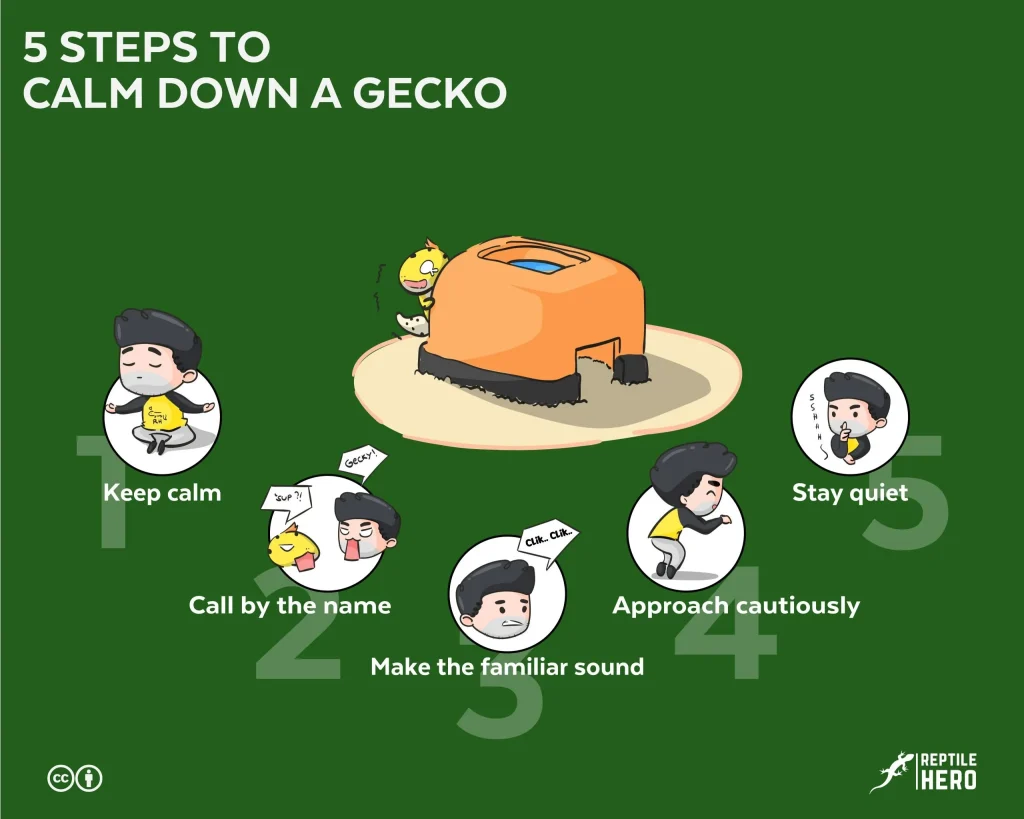Geckos are fascinating creatures that make great pets. However, they can be easily stressed and become agitated, making handling and interaction difficult. Knowing how to calm down a gecko is an important skill for any gecko owner. In this article, we will cover five simple steps to help your gecko relax and feel safe in its environment.
Geckos can be easily overwhelmed and stressed, but calming them down is a simple process. Here are 5 steps to help calm down a gecko:
- Turn off any bright lights and loud noises in the room to create a calm environment.
- Approach the gecko slowly and speak softly to it to avoid startling it.
- Offer a treat, such as a small insect, to help distract and calm the gecko.
- Slowly and gently stroke the gecko’s back to help it relax.
- Allow the gecko to rest and continue to provide a calm environment until it has fully calmed down.

5 Steps to Calm Down a Gecko
Geckos are fascinating creatures, but they can be quite skittish and difficult to handle. It’s important to know how to calm down a gecko if you want to handle them safely and without causing them stress or harm. In this article, we’ll discuss five steps you can take to calm down a gecko and make handling them a breeze.
Step 1: Approach Them Calmly
When approaching your gecko, it’s important to do so calmly and slowly. Sudden movements can startle them and make them feel threatened, which can cause them to become aggressive or defensive. Instead, approach your gecko with slow and deliberate movements, speaking to them in a soft and soothing voice. This will help your gecko feel more at ease with you.
It’s also important to avoid direct eye contact with your gecko, as this can be seen as a threat. Instead, look at them from the corner of your eye or focus on their body language to gauge their mood and behavior.
Step 2: Offer Them a Hiding Place
Geckos are natural hide-and-seek players, so offering them a place to hide can help them feel safe and secure. You can use a small cardboard box or a plastic container with an opening for them to crawl into. This will provide your gecko with a sense of security and give them a place to retreat to if they feel threatened or scared.
It’s important to make sure that the hiding place is well-ventilated and not too small for your gecko. You should also make sure that the hiding place is easily accessible and not too far away from their usual habitat.
Step 3: Use a Soft Touch
When handling your gecko, it’s important to use a gentle and soft touch. Geckos have delicate skin that can be easily damaged, so it’s important to avoid squeezing or grasping them too tightly. Instead, use a light touch that allows them to move freely and comfortably.
You should also avoid handling your gecko by their tail, as this can cause it to detach from their body. If your gecko feels threatened or scared, they may drop their tail to distract their predator and make an escape. While the tail will eventually grow back, it’s important to avoid causing unnecessary stress to your gecko.
Step 4: Create a Calm Environment
Geckos are sensitive to their environment, so creating a calm and quiet space can help them feel more relaxed and at ease. You can do this by dimming the lights, playing soothing music, and avoiding sudden movements or loud noises.
It’s also important to maintain a consistent temperature and humidity level in their habitat. Geckos are cold-blooded animals, so they rely on external heat sources to regulate their body temperature. Make sure to provide a heat source that’s appropriate for their species and keep the temperature consistent throughout the day.
Step 5: Offer Them Treats
Offering your gecko treats can help them associate you with positive experiences and make them feel more comfortable around you. You can offer them crickets, mealworms, or other insects that they enjoy eating. This will help your gecko associate you with positive experiences and make them more likely to approach you willingly.
When offering treats, make sure to do so in a calm and gentle manner. You can use a pair of tweezers or tongs to hold the treat and offer it to your gecko. This will prevent them from accidentally biting you and help keep both you and your gecko safe.
In conclusion, calming down a gecko requires patience, understanding, and a gentle touch. By following these five steps, you can create a safe and comfortable environment for your gecko and build a positive relationship with them. Remember to approach them calmly, offer them a hiding place, use a soft touch, create a calm environment, and offer them treats to make handling your gecko a breeze.
Frequently Asked Questions
Q1. How can I tell if my gecko is stressed?
If your gecko is stressed, it may exhibit certain behaviors such as hiding more often than usual, refusing to eat, or becoming more aggressive. You may also notice changes in its appearance, such as a paler coloration or a thinner tail.
It is important to address the cause of your gecko’s stress as soon as possible to prevent further negative effects on its health.
Q2. What are some common causes of stress in geckos?
Geckos can become stressed for a variety of reasons, including changes in their environment, improper handling, inadequate nutrition, or exposure to other pets or predators.
To prevent stress in your gecko, it is important to provide a stable and comfortable environment, handle it gently and appropriately, provide a balanced diet, and keep it away from potential threats.
Q3. How can I calm down my gecko if it is stressed?
If your gecko is stressed, there are several steps you can take to help calm it down. These include providing a hiding spot in its enclosure, reducing noise and disturbances in its environment, and avoiding handling it excessively.
You can also try offering your gecko some food or a comfortable surface to climb on, as this may help it feel more secure and relaxed.
Q4. What are the 5 steps to calm down a gecko?
While there is no one-size-fits-all solution to calming down a gecko, there are some general steps you can take. These include:
1. Providing a hiding spot in its enclosure
2. Reducing noise and disturbances in its environment
3. Avoiding excessive handling
4. Offering food or a comfortable surface to climb on
5. Giving your gecko time to adjust to any changes in its environment or routine.
Q5. When should I seek veterinary care for my gecko?
If you notice any signs of illness or injury in your gecko, such as lethargy, loss of appetite, or unusual behaviors, it is important to seek veterinary care right away. Additionally, if you are unsure about how to properly care for your gecko or have any concerns about its health or well-being, a veterinarian who specializes in reptiles can provide valuable guidance and advice.
Regular check-ups with a veterinarian can also help ensure that your gecko stays healthy and happy for years to come.
In conclusion, calming down a gecko is not as difficult as it may seem. By following the five steps outlined above, you can create a safe and comfortable environment for your pet and help them feel more relaxed and at ease.
Remember to start by understanding your gecko’s behavior and body language, and then gradually introduce them to new situations. Provide plenty of hiding spots and a consistent routine to help them feel secure.
By practicing patience and persistence, you can help your gecko overcome their fear and thrive in their new home. With these tips and a little bit of love and care, your gecko will be happy and healthy for years to come.


